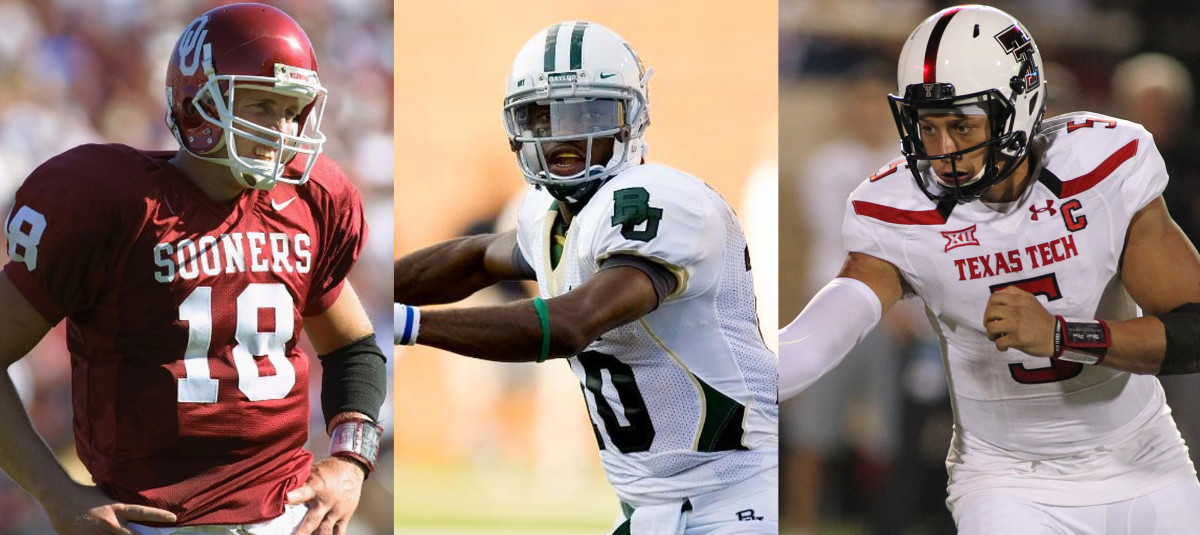Top 25 Players in Big 12 History: No. 25
As the Big 12 Conference ramps up its 25th football season, it seems like a good time to look back through the league’s illustrious history and identify the best football players ever to suit up.
It was a daunting task to rank players from 14 schools over 24 seasons — some schools, of course, didn’t participate in all 24 years. But players from the original Big 12 (including Colorado, Missouri, Nebraska and Texas A&M) had the same opportunity to earn a spot as players from the new Big 12 members (TCU and West Virginia).
Rather than select an all-time All-Big 12 team — we’ll endeavor to pull that off after the 25th season has concluded — publishers from SI affiliates who currently cover the Big 12 were asked to vote on their top 25 players. The results were literally all over the board.
Players were judged on both their college careers and their professional football exploits. National awards, championships and individual achievement were all considered.
In all, nearly 50 players received votes. Only 10 players were unanimous selections.
With that, the countdown begins with No. 25:
- - - -

Wouldn’t you know it? In a league renowned for excellent quarterback play, it’s a three-way tie for 25th.
Baylor’s Robert Griffin III, Texas Tech’s Patrick Mahomes and Oklahoma’s Jason White all received the same number of votes.
Griffin won the 2011 Heisman Trophy as college football’s most outstanding player. He was a consensus All-American and player of the year by both the Sporting News and Associated Press. RG3 also won the Davey O’Brien Award and the Manning Award as the nation’s top quarterback.
Griffin, a state record hurdler from Copperas Cove, TX, in high school and a Big 12 champion in the hurdles as an early enrollee at Baylor in 2008, was a starter for the Bears as a true freshman, but then tore his ACL early in week three of his sophomore season.
In 2010, Griffin broke out with 3,501 yards passing with 22 touchdowns and eight interceptions while also rushing for 635 yards and eight touchdowns.
As a fourth-year junior in 2011, Griffin dominated the competition as he led Baylor out of 16 years of losing football. With Griffin throwing for 4,293 yards and 37 touchdowns with just six interceptions and rushing for 699 yards and 10 TDs, Baylor finally left the Big 12 basement with a 10-3 record. Many think his last-minute TD pass to beat OU in Waco was his Heisman moment.
Griffin’s success seemed to follow him to the NFL, where he went to Washington with the No. 2 overall pick and signed a four-year, $21.1 million deal. Griffin earned a spot in the Pro Bowl and was named 2012 NFL Offensive Rookie of the Year before suffering a knee injury late in the season and then reinjuring it again in a playoff game.
Griffin struggled much of the rest of his NFL career as injuries and demotions took him out of the lineup. He’s beginning his ninth year in the league and his third as a backup with the Baltimore Ravens.
Like Griffin, Mahomes was a two-sport star, only Mahomes dabbled in baseball after his Major League father.
Mahomes began his freshman season in Lubbock as backup to Davis Webb, but took over after Webb went down with injury late in the 2014 season.
Mahomes was the starter in 2015 and threw for 4,653 yards and 36 touchdowns with 15 interceptions, then left baseball to focus on football and really took off with 5,052 passing yards and 53 total touchdowns.
During his junior year, Mahomes dueled with Baker Mayfield in a 66-59 loss to Oklahoma, setting multiple NCAA, Big 12 and Tech records including total offense (819 yards) and passing yards (734).
Mahomes won the Sammy Baugh Trophy as college football’s top passer and made second-team All-Big 12.
He was the No. 10 overall pick of the Kansas City Chiefs in 2017, signing a four-year, $16.42 million deal with a $10.08 million signing bonus. He backed up Alex Smith in 2017, then won the NFL’s MVP award in 2018 with 5,097 yards, 50 touchdowns and just 12 interceptions.
He topped that last season by winning the Super Bowl and earning Super Bowl MVP, then signed the largest contract in American pro sports history, a 10-year, $477 million extension.
White grew up an Oklahoma fan in nearby Tuttle, but nearly accepted a scholarship offer from the Miami Hurricanes. Instead, White became one of the most decorated and respected Sooners of all time.
After backing up Josh Heupel in 1999 and 2000, White beat out Nate Hybl for the starting job in 2001, but suffered torn knee ligaments against No. 1-ranked Nebraska.
He won the job again in 2002, but blew out his other knee in the second game of the year against Alabama.
After two years of rehab, White won the job again in 2003, then threw for 3,846 yards, 40 touchdowns and 10 interceptions on his way to winning the Heisman Trophy. He also won the Davey O’Brien Award as the top quarterback in the nation, the Maxwell Award as college football’s top overall player, Sporting News Player of the Year, AP Player of the Year and was named unanimous All-American as he led the Sooners to a national championship game loss to LSU.
In 2004, OU went undefeated, won the Big 12 and went back to the BCS title game, where the Sooners lost to USC. White finished third in the Heisman voting, repeated as the Davey O’Brien Award winner and took home the Johnny Unitas Golden Arm Award as he threw for 3,205 yards with 35 touchdowns and nine interceptions.
Because of his knees, White went undrafted — just the third Heisman winner to not be selected after Army’s Pete Dawkins (military) and Florida State’s Charlie Ward (NBA). But he did get a tryout with Kansas City. Chiefs coaches were effusive with their praise of White’s arm and accuracy, but he could barely crouch under center to take snaps. The Tennessee Titans offered him a contract, but White instead decided to retire from football and is now in private business in Oklahoma.
Tomorrow: No. 24.
To get the latest OU posts as they happen, join the SI Sooners Community by clicking “Follow” at the top right corner of the page (mobile users can click the notifications bell icon), and follow SI Sooners on Twitter @All_Sooners.
